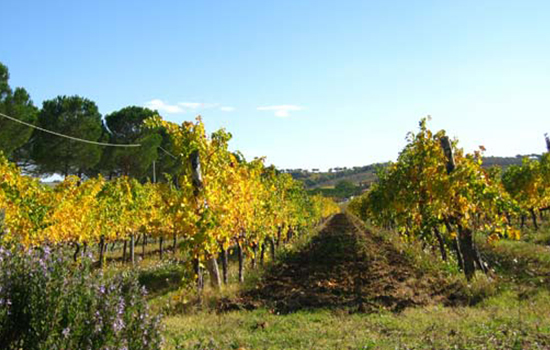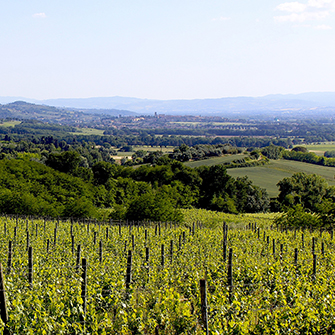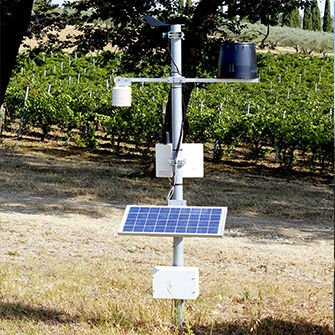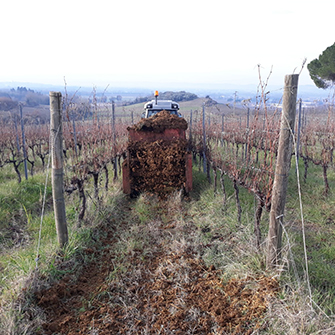Sustainability in Torgiano and Montefalco
An ancient Navajo proverb says that “the Earth is not an inheritance received from our fathers, but a loan to be repaid to our children”, for the Lungarotti family this is a real mantra. We must protect the earth and rethink every step of that hard work which allows man to reap the best fruits.
Our project is divided into four main thematic areas, represented by the 4 C’s:
Countryside
Cellar
Culture
Community
COUNRTYSIDE
Approach: everything starts from the awareness that the land must be worked with the utmost respect; as winemakers we must think that we are guardians of the beauty of the landscape and that we are responsible for the health of the nature that hosts us. We continue the agricultural activity in places where it has presided over valleys and hills for centuries, allowing civilization to continue to evolve while maintaining a delicate balance with the surrounding environment. We have an obligation to protect and improve this balance, passing the culture of respect from generation to generation, we are called to reduce our Carbon Footprint, to indulge nature rather than dominate it, being aware that the whispered sustainable revolution is in the hands of many and not on the shoulders of a few. Setting an example, telling stories, embracing the new generations in order to improve the health of the land that provides us with the fruits to produce our wines. Nature and ingenuity, tradition and innovation, scientific data and common sense.
– Analysis of climatic trend data
– MeteoWine project
– Rational soil management
– Regenerative Agriculture
– Recovery sprayers
– Mechanical weed control
– Management of water resources
– Organic fertilization and green manure
– Carbon sequestration
– Protection of soil biodiversity
– Precision viticulture
– Maintenance of natural thickets
– Maintenance of ditches and dirt roads
– Laghetto alla Palla (a lake for micro-climate and water resource)
– Vine support materials
– Experimentation
– Educational farm
– Agricultural resilience
CELLAR
Approach: even in the cellar we have made a series of choices that testify our commitment to respecting the environment. From reducing energy use, to producing and using energy from renewable sources, up to packaging. The vision of the Lungarotti family is that of the craftsman, the one who thinks, creates and markets, perfectly representing the approach to work that has been common in our country since the Middle Ages.
– Sustainable packaging
– Photovoltaic panels
– Recovery of cooling water
– Small daily acts
– CO2 compensation
– Use of low consumption equipment
– Short supply chain
– Low level of Sulfites
CULTURE
Approach: culture is the paradigm that allows man to adapt and improve the world around him. Culture in Lungarotti has a fundamental value starting from the two museums (of wine and olive oil) which are two dynamic totems bearing witness to man’s ingenuity and the essence of agricultural work. They are not museums on Lungarotti but on the “agri – culture” of Umbria, Italy, and all the civilizations surrounding the Mediterranean across the millenia.
– Culture and work
– Collaborations with universities and Umbria Institute
– Collaboration with Dr. Storchi from Crea Arezzo for viticultural research.
– Museums
– Writing books on healthy approach to wine consumption
– Part of the association for responsible drinking Drink in Moderation
COMMUNITY
Approach: taking care of the community in which we operate and helping it to thrive is essential in order to be able to leave a sign that improves the planet starting from the surrounding environment
– Public service
– Work life balance for our workers and partners
– Generations of workers like in the Bordeaux tradition
– Cycle of events and activities to keep Torgiano vibrant even during winter
The “V.I.V.A.” project
The V.I.V.A. project (Evaluation of Viticulture’s Impact on the Environment) was initiated by the Ministry of the Environment specifically for the wine sector; it gives companies the instruments to diagnose the impact of their product and at the same time is a guarantee and an affirmation of transparency for consumers.
Its goal is to set a standard for sustainable management of the viticultural and winemaking sector that is both measurable and accredited: a standard reference for Italian products and a prestigious promotional tool for «made in Italy» on international markets.
In 2018 we were granted V.I.V.A certification for a correct performance in sustainably managing all 4 of the indicators present in the specifications (air (Carbon Footprint), water (Water Footprint), vineyard and territory) following a series of assessments initiated about 2 years earlier. Lungarotti is the ninth Italian organization to obtain VIVA certification and the first in Umbria.
“The Green Heart Quality” mark
Green Heart Quality is the certification (brand) for environmental sustainability from the Region of Umbria. The region, also known as the Green Heart of Italy, is the first in Italy to have instituted an environmental brand for certifying and recognizing entities that follow a green philosophy.
The Green Heart Quality brand identifies not only companies and products but also services, institutions and environmentally sustainable events. The brand promotes and acknowledges «environmental excellence










